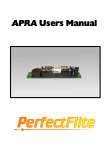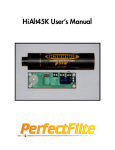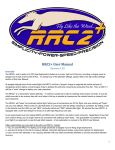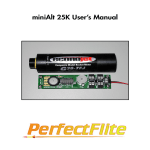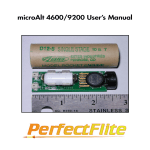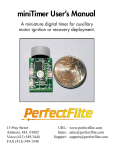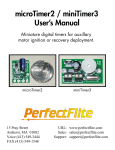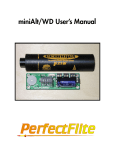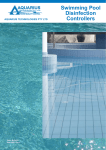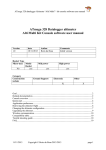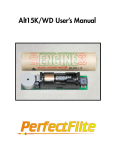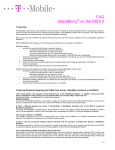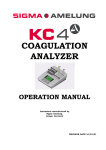Download StratoLogger - PerfectFlite
Transcript
StratoLogger SL100 Users Manual StratoLogger SL100 Users Manual A miniature, high accuracy, extreme range altimeter with two event deployment and flight data logging. PO Box 29 Andover, NH 03216 Voice (603) 735-5994 FAX (603) 735-5221 URL: www.perfectflite.com Sales: [email protected] Support: [email protected] Contents Introduction................................................................................................. 1 Two Event Deployment......................................................................... 4 Parts Identification Diagram.............................................................. 6 Installation Avionics Bay Construction.......................................................................................... 7 Static Pressure Sampling Ports................................................................................. 9 Powering and Connections...................................................................................... 10 Operation Numerical Reporting.................................................................................................. 16 Powerup Sequence...................................................................................................... 17 Changing Settings in the Field................................................................................ 20 Changing Settings with a Computer.................................................................... 23 Quickstart for Experienced Users................................................. 28 Additional Information Shear Pins........................................................................................................................ 31 Electric Matches........................................................................................................... 33 Ejection Charges........................................................................................................... 35 Ground Testing............................................................................................................. 37 Mounting Template..................................................................................................... 41 Telemetry Information...............................................................................................42 Avionics Bay Manufacturers................................................................................... 44 Electric Match Sources.............................................................................................. 45 Cautions....................................................................................................... 46 Preflight Checklist.................................................................................. 47 Specifications............................................................................................ 48 Warranty................................................................................... Back Cover Introduction The StratoLogger SL100 is one of the most accurate, versatile, and affordable rocketry altimeters available. It can be used to: • Determine precisely how high your rocket went (up to 100,000 feet above sea level). • Log and save full flight data (altitude, temperature, and battery voltage) from the last 31 flights for later download to a computer. The 32nd and subsequent flights will replace the oldest flights, so you will always have a record of the most recent 31 flights. • Provide control over firing a drogue and main parachute (single or two event deployment). • Report the peak altitude and maximum velocity audibly after the flight. If you are already experienced with rocketry electronics and don’t want to read the introductory sections of the manual, please refer to page 28, “QuickStart for Experienced Users”, for an explanation of the powerup sequence and SL100specific operational characteristics. If you are new to rocketry electronics please take the time to read the manual thoroughly; in addition to learning about operating the altimeter you will also find information about many other topics including proper testing procedures, hints and checklists for two event deployment, making ejection charges, and more. 1 The StratoLogger altimeter utilizes a precision pressure sensor and 24 bit delta sigma analog to digital converter to obtain an extremely accurate measurement of the air pressure surrounding your rocket. As the rocket rises, the pressure decreases, and the altimeter converts the pressure differential to a precise measurement of altitude above launch point according to the US Standard Atmosphere model. Throughout the entire ascent, the altimeter also calculates the instantaneous and smoothed velocity of your rocket, and uses this information to determine when it has reached apogee (zero vertical velocity). Because of the high resolution of the data, it is able to determine the moment of apogee with phenomenal accuracy, typically within +/- 0.2 seconds. If you use the altimeter to control the deployment of your parachute(s), this precise timing will insure deployment at minimum velocity, preventing damage such as “zippered” body tubes or “stripped” chutes that can occur with early or late deployment. The velocity data are also analyzed during flight so that “mach dips” (an apparent drop in altitude due to the increase in pressure when a high performance rocket exceeds the speed of sound) are not incorrectly interpreted as apogee. This MachLock feature eliminates the possibility of your drogue chute being ejected during a mach dip, without the need for older-technology mach delay settings. You don’t have to worry about setting a mach delay, or having a mach delay interfere with timely deployment on an aborted flight – apogee will be determined correctly regardless of the speed of your rocket without any user intervention. 2 The altimeter has two electronic outputs for firing parachute deployment ejection charges using electric matches. If you connect a single electric match and associated ejection charge to the apogee output, you will get single event deployment – similar to normal motor-based deployment but with greater accuracy and no worries about selecting the right ejection delay time. You can also use two electric matches and two ejection charges for two event deployment: The charge connected to the apogee output will separate your rocket and eject a small drogue chute at apogee, and the charge connected to the “main” output will deploy a larger chute at an altitude that you select closer to the ground. The next section describes this feature in more detail. The StratoLogger has an on-board data connector that is used for two basic functions: Post-flight retrieval of saved data from the altimeter, and real time data output during flight using the telemetry feature. The optional data transfer kit and software allow the user to transfer flights from the altimeter’s internal memory to a computer for storage, display, and manipulation. The data transfer kit can also be used to configure various settings within the altimeter, including nine “presets” of userspecified parameters that can be easily selected at the launch site when a computer may not be available. For advanced users, the telemetry feature can be used to send in-flight data back to the ground during flight using an RF modem (not included), or for experimental payloads that need current altitude data to control functions in real time. 3 Using Two Event Deployment Recovery of your rocket can sometimes involve a long hike, especially if it is windy, your field size is limited, and your rocket achieves some serious altitude. Making your parachute smaller is one option to limit the distance your rocket will drift. This has the undesirable side effect of increasing landing velocity, with subsequent damage to your rocket (broken fins, airframe damage, etc). A better solution is to use the drogue and main deployment ability of the StratoLogger. At apogee, an ejection charge connected to the “Drogue” terminal block separates the rocket and deploys a small drogue chute. The rocket descends rapidly under the drogue chute to minimize drift from the launch point. When it has descended to the predetermined “main deployment altitude”, a second ejection charge connected to the “Main” terminal block deploys a much larger chute that slows the rocket to a safe speed before landing. If you usually use a descent rate of 15 FPS to insure minimal damage to your rocket, and launch to 5,000 feet in a 10 MPH (approximately 15 FPS) wind, your rocket will drift nearly a mile before it lands. However, if you let it fall at 100 FPS from apogee to 500 feet, and then use a larger main chute to get the final 15 FPS landing speed, the drift will be reduced to just over 1,000 feet (about 1/5 of a mile). This is a significant improvement! If you will be using two event deployment, the user-defined “main deploy altitude” setting that is reported during altimeter powerup specifies how many feet above the launch point elevation the main chute is to be deployed at. The procedure for changing this setting is described in a later section. 4 You should set the altitude high enough to insure that the chute will deploy fully in time to slow the rocket’s final descent, but low enough to prevent excessive drift. In most cases a setting of 500 to 900 feet is appropriate. If you have any doubt as to the time it will take for your chute to deploy, choose a number towards the upper end of this range and gradually reduce it if deployment speed allows. For small fields, loosely packed chutes, and windy conditions you may need to drop back to 300 to 400 feet. Note: Make sure you don’t swap the main and drogue wiring to the altimeter! If you mistakenly connect the main ejection charge to the drogue terminals and vice versa, your large main chute will deploy at apogee, defeating the purpose of two event deployment. 5 Parts Identification Refer to the picture below to locate the following items: A) Battery Terminal Block: Connect a 4 volt to 16 volt power source here. A 9V battery clip is supplied, connect red to “+” and black to “-”. Polarity (+/-) must be correct or altimeter will not power up. Reverse polarity will not damage the altimeter. B) Power switch Terminal Block: Remove factory supplied jumper and connect a power switch here. Must be connected to an external switch or shorted with a jumper or the altimeter will not power up. C) Main Ejection Output Terminal Block: Connect to the electric match for the main deployment charge (if used), or leave unconnected otherwise. DO NOT SHORT CIRCUIT! D) Drogue Ejection Output Terminal Block: Connect to the electric match for the drogue/apogee deployment charge (if used), or leave unconnected otherwise. DO NOT SHORT CIRCUIT! E) Data I/O Connector: For connection of the optional data transfer kit or user-supplied in-flight telemetry equipment. F) External Audio Connector: For connection of an optional remote beeper or LED. G) Beeper: Audibly reports settings, status, etc. via a sequence of beeps. H) Preset Program Button: For selecting and modifying the 9 user settings presets (see pages 20-22). 6 Installation The altimeter and battery should be installed in an “avionics bay” inside your rocket. The avionics bay performs a number of functions: • Provides a secure mounting point for your altimeter and related gear (battery, switch, wiring, etc). • Isolates the altimeter from high pressure and corrosive residue from ejection charge gasses. • Provides a facility for mounting and connecting ejection charges if the altimeter will be used for deployment. • Provides access to the altimeter’s power switch from the outside of the rocket. • Has one or more “static pressure sampling” holes so the altimeter will be exposed to the ambient air pressure surrounding the rocket. The next few paragraphs will give you some basic ideas for setting up your avionics bay. There are many variations possible; you should plan your installation carefully and research how others have done their installations for additional ideas. Avionics Bay Construction An avionics bay is typically constructed of a section of coupler tube to fit the rocket’s airframe, with a fixed bulkhead at one end (usually forward) and a removable bulkhead at the other (aft) end. The removable bulkhead allows access to the altimeter and battery between flights. Both bulkheads need to have a good airtight seal so that ejection gas pressure doesn’t 7 get into the interior of the avionics bay. The fixed bulkhead will typically be attached with epoxy, which will seal it as well. The removable bulkhead can be sealed with a large rubber Oring, gasket, or a thin bead of dried silicone sealant. Good, sturdy eye bolts facing outward from each bulkhead provide attachment points for the drogue and main shock cords. With larger, heavier rockets you should consider using forged eye bolts with a continuous “O” eye, rather than the more common bent rod eye bolts with a gap in the “O”. The forged eye bolts are much stronger, and will be less likely to open up and allow your recovery system to separate under heavy loads. The bulkheads are then connected to each other inside the coupler tube with two (or more) sections of all-thread rod that extend through the bulkheads, with washers and nuts on the outside. This creates a strong connection from one eye bolt to the other one, for integrity of your recovery system’s strength. With larger, heavier rockets you may want to use stronger bulkhead material such as thicker plywood, fiberglass, or aluminum. A plywood or G10 fiberglass “sled” for mounting the altimeter and battery is then attached to the all-thread rod inside the coupler, either directly (e.g. with epoxy), or indirectly on pieces of tubing that slide over the all-thread. The indirect mount allows the sled to be removed for access without removing the all-thread from the fixed bulkhead. 8 Static Pressure Sampling Holes You must drill one or more clean-edged holes in the airframe into the avionics bay to allow outside air pressure to be sampled by the altimeter (see table below for recommended sizes). These holes should be as far away from the nosecone shoulder and other body tube irregularities as possible (at least 4 to 5 times the body tube diameter or more) to minimize pressure disturbances being created by turbulent airflow over the body tube. Sand the area around the hole as necessary to eliminate flashing or raised edges. Best performance will be achieved by using four smaller holes distributed at 90 degree intervals around the airframe’s circumference instead of a single larger hole. When using four holes, each hole should be ½ the size of a single hole as noted in the table. This will minimize the pressure variations due to wind currents perpendicular to the rocket’s direction of travel. With any high performance rocket, pay particular attention to the size and placement of the holes – do not make them too large or too far forward! If your rocket has an irregular nosecone (e.g. Honest John, Nike Smoke) you should move the holes even further back. AvBay Diameter AvBay Length Single Port Hole Size Four Port Hole Size 1.6” 2.1” 3.0” 3.0” 3.9” 3.9” 5.5” 7.5” 6” 6” 8” 12” 8” 12” 12” 12” .032” .048” .113” .170” .202” .302” — — .020” (small pinholes) .025” .057” .085” .101” .151” .286” .5” Single Port, hole size = Diameter * Diameter * Length * 0.0016 Four Ports, each hole = Diameter * Diameter * Length * 0.0008 9 Powering the Altimeter The altimeter’s electronics can be powered by any source of 4 volts to 16 volts. All of the electric match firing current must come from the battery; if your ematch requires 3 amps to fire, your battery has to be able to supply this much current. Most commonly-available commercial ematches (e.g. Mtek, Jtek) require less than one ampere to fire, and a good 9 volt alkaline battery can supply more than 3 amps of current. Do not exceed the 10 ampere current limit of the StratoLogger’s firing circuitry or damage may occur. Standard 9V batteries can be connected using the supplied battery clip. Make sure that both of the clip’s snaps are gripping the battery terminals firmly to prevent power interruption due to vibration. The larger battery terminal or clip terminal can be compressed inward if necessary to insure a snug fit. While the StratoLogger will fit easily inside a 24mm body tube, a standard 9V battery will not. For limited-space applications we recommend a battery consisting of 5 or 6 type SR-44/357 Silver Oxide cells in series. This configuration is small enough to fit in a type “N” battery holder, yet provides enough power to run the altimeter for over 150 hours. Using less costly Alkaline LR44cells will reduce the runtime, especially in colder weather. Many types of batteries (12V A23 batteries, lithium batteries, LiPo batteries, etc.) can be used to power the altimeter, but may have a low maximum discharge current, which could be insufficient to fire even the lowest current electric matches. Especially if you use a non-standard battery or electric match, make sure you ground test the combination before committing it to flight. It is a prudent practice to make sure 10 that your chosen battery will fire twice the number of electric matches that you plan to use in flight to insure a margin of safety. If you will be using a single ematch in flight, make sure your battery will fire two (in parallel) reliably and consistently during tests. If you will be using two ematches per output for redundancy in flight, make sure your battery will fire three or four in testing. Terminal Block Note To attach wires to the terminal blocks, loosen the retaining screw (facing upward from the board), insert the stripped wire end from the side, and retighten the screw. Make sure that you strip enough insulation from the wire (~3/16”) so the bare wire (not the insulation) is gripped by the contact. Do not allow an excess of bare wire outside the terminal, as it could short-circuit to adjacent parts or wires. Always use solid wire (or tin any stranded wire ends with solder); the loose strands in untinned stranded wire can “escape” during wire insertion and make contact with adjacent terminals. After inserting the wires and tightening the connections, tug the wires with a pair of longnose pliers to insure that they are gripped tightly. You do not want these connections to loosen in flight! Power Switch Connect a suitable ON/OFF switch to the altimeter’s power switch terminals. One important consideration for the power switch is that it be “bounce-free” – you do not want the switch to turn off momentarily during vibration or acceleration, as the altimeter could reset and deployment would fail. 11 The StratoLogger can tolerate a power loss of several seconds (depending on battery voltage) without resetting, but it is always wise to use the best quality switches possible. Note: While the altimeter will continue to operate during momentary power outages, the ejection outputs will not fire if power is absent at the point that they are turned on. It is best to mount the power switch with the switch movement perpendicular to the travel of the rocket. This will minimize the forces placed on the switch during acceleration and deceleration, which could inadvertently move the switch to the “off” position. The switch should be inside your rocket, with a means of accessing it from the outside. Having access to the altimeter’s on/off switch from outside the rocket is essential. When ejection charges are installed, the altimeter should only be powered up with the rocket fully assembled, on the pad in the upright position. It is also imperative that the switch cannot be accidentally turned off in flight by contact with the shock cord or any airframe parts. Do not use a slide switch or toggle switch with the actuator on the outside of the rocket! Keeping the switch entirely inside the avionics bay is good practice, with a provision for activating it from outside at the appropriate time. Keyed lock-type switches are often used, as are either alternate action “push on/push off” switches or “pull pin” switches that are activated through a hole in the side of the airframe. If you use any kind of internal switch that needs to be activated through an open hole in the side of the airframe, make sure that the hole (which will then become one of your static pressure sampling holes) doesn’t exceed the static port sizing guidelines mentioned above. 12 A simple and effective pull-pin type switch can be made using a pin plunger microswitch (eg. Omron SS-10T, or PerfectFlite SAS5), a small piece of brass tubing, and a length of brass rod with a sharpened end. The brass tubing is secured to the top of the switch housing with a small amount of epoxy (do not use CA, as the outgassing produced during curing can get into the switch and ruin its contacts) such that when the sharpened end of the brass rod is inserted into the tubing it depresses the plunger. The switch assembly is mounted inside the altimeter bay, with a hole for the brass rod leading to the outside. The Normally Closed terminals of the switch are used in this case, so when the rod is inserted and the plunger is depressed the switch turns off (“opens”). A “remove before flight” flag can be hung from the end of the brass rod to remind you to turn on the altimeter. One advantage to using a Normally Closed switch is that failure of the external mechanical assemblies (brass tube) during flight will NOT turn the altimeter off. Rod removed, switch ON Rod inserted, switch OFF 13 Charge Holders Ejection charge holders can be incorporated into the avionics bay’s fore and aft bulkheads. If you will be making reloadable ejection charges out of short sections of small diameter PVC pipe, matching PVC caps can be screwed to the bulkhead to hold the charges. Adding a small terminal block adjacent to the ejection charge, with wires leading in to the altimeter, makes connecting and removing ejection charge wires a snap. Make sure that any wires going through the bulkhead are sealed – silicone or epoxy works well for this. Placement If you will be setting up your rocket for two event deployment, the avionics bay will usually be in the center of the rocket, with the drogue ejection charge facing aft and the main ejection charge facing forward. This is because the altimeter needs to have electrical connection to both the drogue and main charges; if it were placed in the booster section, for instance, the connection to a main chute in the forward section would be broken when the rocket separated at apogee. There are many alternatives to this approach, but placing the altimeter in the middle of the rocket with drogue aft and main forward is generally the simplest and most straightforward. At apogee, the drogue charge separates the rocket between the booster section and the forward section, which includes the avionics bay, main chute compartment, and nosecone. The booster section and forward section are connected by a long shock cord with a small drogue chute attached. When the rocket has descended to the preset main deploy altitude, the main ejection charge fires, pressurizing the main chute 14 compartment in the forward section of the rocket, forcing the nosecone off and deploying the main chute. Single event deployment works in a similar manner, except the primary chute is released at apogee. Since there is only one separation point with single event deployment, you have more flexibility as to where the altimeter can be placed. It can be placed in the forward section of the rocket, as in the previous example, or in the booster section (or even inside the fin can). There are many possible variations to these installation methods. For instance, if your rocket has a limited amount of useable airframe length to work with (e.g. Nike Smoke) you can arrange for two event deployment with a singe separation point. At apogee, the nosecone is popped and a small chute released. At the main deploy altitude, an ejection charge inside a “parachute cannon” in the booster section deploys the main chute that was stored in the cannon. Another alternative in larger diameter airframes is to deploy a drogue chute aft out of the rear-most centering ring, with the main being deployed behind the nosecone as usual. 15 Operation Numerical Reporting Numbers are reported as a long beep (separator), followed by a pattern of shorter beeps for the individual digits, with a pause before the next digit. You simply count the number of short beeps for each digit place and assemble them together to form a number. You will hear a series of beeps for the first digit (tens of thousands of feet), a short pause, another series of beeps for the next digit (thousands of feet), etc. Ten beeps are used to indicate the number zero (if zero beeps were used, you would not be able to differentiate between 2200 feet and 22 feet!). As an example, 12,560’ would be reported as: long beep-pause-beep-pause-beep-beep-pause-beep-beep-beepbeep-beep-pause- beep-beep-beep-beep-beep-beep-pause-beepbeep-beep-beep-beep-beep-beep-beep-beep-beep-long pause Digit Reported as: 0 1 2 3 4 5 6 7 8 9 beep-beep-beep-beep-beep-beep-beep-beep-beep-beep beep beep-beep beep-beep-beep beep-beep-beep-beep beep-beep-beep-beep-beep beep-beep-beep-beep-beep-beep beep-beep-beep-beep-beep-beep-beep beep-beep-beep-beep-beep-beep-beep-beep beep-beep-beep-beep-beep-beep-beep-beep-beep 16 Powerup The StratoLogger has a number of user-changeable settings that can be modified to tailor its operation to various flight conditions. However, the factory-default settings will be appropriate for most normal flights, and the altimeter can be used right out of the package with no modifications. Just bolt it in, connect power, a switch, and your ejection charges, and you’re ready to go. A rundown of the changeable settings and how to modify them will be addressed in a later section. When the altimeter is turned on, it will report some settings and pieces of information before readying itself for flight. This is what you will hear: • A one digit number (range of 1 to 9) corresponding to the currently-selected program preset. The preset stores the main chute deployment altitude setting (and the apogee delay setting, if used). The factory default is preset 3, which equates to main deployment at 700 feet and no apogee delay (see table on page 22). • A two second pause, and then a three or four digit number (range of 100 feet to 9,999 feet) corresponding to the main deploy altitude setting from currently-selected program preset. This is the altitude that your main chute will deploy at. • (optional, only if you have added an apogee delay to the currently selected preset: A two second pause, and then a five second continuous tone to warn you that your apogee firing is set to be delayed. If you hear this tone, and don’t expect an apogee delay, then: STOP, do not launch, and either modify the preset with a computer or select another preset that does not have an apogee delay.) 17 • A two second pause, and then a three to six digit number (range of 160 feet to 103,500 feet) representing the apogee altitude of the last flight. Note: A warbling siren tone will sound instead of the last flight altitude if power was lost during the last flight. This error will clear after the next good flight. • A two second pause, and then a two or three digit number representing the battery voltage in tenths of a volt (e.g. 9.2 volts would report as 92). • A two second pause (or more if you have added an optional Powerup Delay using the setup software), and then continuity beeps repeated every 0.8 seconds: a single beep means drogue ematch continuity is OK, two beeps means main ematch continuity is OK, three beeps means both drogue & main have good continuity. If the altimeter remains silent at this point, it means that there is no continuity on either ematch terminal block. If reported continuity does not match what you expect, inspect your ematch wiring and correct before launching! While reporting continuity, the altimeter will begin tracking ground level pressure, and will continuously update its internal ground reading to follow fluctuations in ground level pressure until time of launch. The altimeter is ready to launch at this point. After flight the altimeter will report in this sequence: • An extra-long tone to indicate the start of the reporting sequence. 18 • A three to six digit number representing the peak altitude in feet. • A long separator tone followed by a two to five digit number representing the maximum velocity during the flight in miles per hour. This number, and its preceding separator, are reported in a higher pitch to differentiate it from the peak altitude number. • If the “siren delay” number is set to a number greater than zero (the default is 5 seconds, and it is changeable in the setup menu of the download software), the altimeter will wait for the specified siren delay time, and then emit a 10 second warbling siren tone. This will aid in locating the rocket if it is hidden from sight in a tree, tall grass, etc. This feature can be especially useful if you have an amplified external beeper connected to the “audio” connector on the StratoLogger. If you do not want to use this feature, set the Siren Delay setting to “0” and it will be disabled. • After a 10 second period of silence, the sequence repeats until power is disconnected. Flight data and peak altitude are preserved when power is turned off. 19 Changing Settings in the Field (no Computer) The Main Deployment Altitude (MDA) setting can be easily changed in the field. There are two ways of accomplishing this: By changing to a different preset with the desired MDA, or by changing the MDA of the preset that you are using. Both methods make use of the PROG button on top of the altimeter. Refer to table on page 22 for a list of the factory programmed presets and their corresponding settings. Preset number 3 (default, highlighted) will be used until another preset is selected. The Main Deploy column indicates that the main will deploy at 700 feet with this preset. If you want a lower MDA, you can simply change to a different preset, such as preset 2, which has a main deploy of 500 feet. If you want a higher MDA, select one of the other presets which has a higher deployment altitude. If you want to use a deployment altitude that isn’t listed on the default chart, you can change the deployment setting of any of the presets using the procedure in step 4 on the next page. If you want the main to deploy at 400 feet, 800 feet, or any multiple of 100 feet up to 9,900 feet, you would simply select and then modify one of the presets to have the desired MDA. If you need even more control over deployment altitude, a later section will describe how to change the MDA in 1 foot increments from 100 feet to 9,999 feet using the computer interface. 20 To change the preset number that will be used in subsequent flights: Hint: Read the following four steps through before starting in order to familiarize yourself with the sequence. Don’t wait until you are out on the field to learn how to change your settings, try it a few times in advance and it will become second nature. Experiment by changing one of the presets to a different value and confirm that you changed it successfully. 1. Hold down the PROG button, then turn on power while continuing to hold the button down (a constant tone will sound while the button is down). 2. Release the button. As soon as the tone stops, tap the button the number of times that corresponds to the preset that you want to select (e.g. tap 4 times to select preset #4). The altimeter will beep to confirm each time you press the button. If you wait too long before entering your number, the altimeter will exit program mode and continue with normal operation. 3. Shortly after you have finished tapping in your preset number, the altimeter will emit another continuous tone. If you don’t want to modify the preset (i.e. you are just selecting the preset for use with the flight, but not modifying the Main Deploy Altitude for the preset) just wait for the continuous tone to stop. When the tone stops, the altimeter will proceed to the normal powerup state and report the new settings, last flight altitude, and battery voltage as described in the earlier “Powerup” section. 4. (optional) If you want to change the preset’s Main Deploy Altitude in addition to selecting the preset, do not wait for the continuous tone to stop in the 21 preceding step. While the tone is still sounding, press and hold the button again. The tone will change pitch to confirm that you are about to change the preset’s setting. When the tone changes, release the button and the tone will stop. You can then tap in a number for the new Main Deploy setting in hundreds of feet (e.g. 9 taps will set to 900 feet, 4 taps would set to 400 feet). If you wait too long before entering your number, the altimeter will exit program mode and continue with normal operation. Shortly after you have finished adjusting your preset’s MDA, the altimeter will proceed to the normal powerup state and report the new settings, last flight altitude, and battery voltage as described earlier. Factory Default Presets: Preset 1 2 3* 4 5 6 7 8 9 Main Deploy (feet) Delay Apogee Firing By (seconds) 300 500 700 900 1100 1300 1500 1700 2500 0 0 0 0 0 0 0 0 0 * Altimeter uses preset #3 by default until changed by user. 22 Changing Settings with a Computer The presets can also be changed via the download software. This allows you more flexibility: you can change the main deploy altitude in increments of 1 foot, and can enter a delay to cause the apogee firing to be delayed in 1 second increments for multi-altimeter setups or for deploying payloads after apogee. You can also change several other general altimeter parameters that apply to all presets (launch detect altitude, additional powerup delay, rocket locator siren, telemetry, etc). The following descriptions assume that you have the software running and the altimeter connected to the computer and powered up. Select the “Settings” menu item from the “Altimeter” menu. A screen will appear with the current settings, altimeter model, altimeter serial number, firmware revision level, and total number of flights listed. Note: You must make the initial connection to the altimeter while the settings are being reported; if you wait until the altimeter goes silent (or is beeping continuity beeps) it will not communicate with the computer. This prevents possible electrical noise from interrupting a flight in progress. Preset Number To change the currently active preset, simply select the radio button adjacent to the desired preset and click “update”. The selected preset will then be used for subsequent flights until it is changed again. Main Deploy Altitude To change any of the presets’ Main Deployment Altitude settings, just select the text for the MDA in the preset that you want to change, enter a new number, and click “update”. The new setting must be in the range of 100 to 9,999 feet; out of range numbers will be replaced with the closest valid numbers. 23 The preset does not need to be selected in order to change the MDA, and you can change as many of the presets’ MDAs as you want with a single “update”; you do not need to do them one at a time. Apogee Delay The Apogee Delay item is provided so that firing of the drogue output on the altimeter occurs a specified time after true apogee. If you have two altimeters (a primary and a redundant secondary backup) connected to separate redundant drogue ejection charges, you can delay the firing of the drogue charge on one of the altimeters to keep them from firing simultaneously. This will prevent possible overpressure and damage to your rocket which could occur if both charges fired at the same instant (you would accomplish the same effect with the main charges by setting them to different MDAs). The Apogee delay can also be utilized to eject payloads at a predetermined time after apogee, using a second altimeter with no apogee delay to eject the drogue chute for recovery at the proper time. The apogee delay is set the same way the Main Deploy Altitude is; simply select the old number, enter a new one, and hit “update”. The number will be constrained to the range of 0 to 5 seconds. Caution: For normal operation, the Apogee Delay should be set to “0”. If you are not using it for one of the purposes mentioned above, do not change it from the factory setting of “0”. Delaying the apogee ejection event can result in damage due to deployment at high speed or impact with ground before deployment. Only use this feature if you are certain of what you are doing! 24 Launch Detect You can change the Launch Detect Altitude by selecting the text, entering a new number, and hitting “update”. The Launch Detect Altitude controls the point that the altimeter “arms” itself and begins the flight sequence. If a flight doesn’t make it to this altitude, the ejection events will never fire and data will not be recorded. The altimeter stores 28 data points (1.4 seconds) of data prior to the time that it reaches the launch detect altitude. This will include data back to the point that the rocket was on the pad in most cases. Valid settings range from 160 feet to 300 feet above ground level. The factory default of 160 feet allows for maximum prelaunch data collection combined with reasonable resistance to wind gust induced false triggering. If you must launch in abnormally high wind conditions, the Launch Detect Altitude can be increased for additional resistance. Powerup Delay An additional delay can be inserted between the time that the altimeter finishes reporting its settings on powerup and when the continuity beeps start as the altimeter looks for a pressure drop signifying launch. This is typically used when a power switch is not accessible from the outside of the rocket and additional time is needed after power is applied to provide time to close up the altimeter compartment and allow pressure to stabilize before the altimeter begins to look for a valid launch condition. Warning: If you will be using the drogue or main outputs to activate ejection charges, you MUST make a provision for turning the altimeter on and off from outside the rocket. If you ever have to abort a flight, you need to turn off (disarm) the 25 altimeter before opening the rocket or altimeter compartment. If you open a rocket that has an active altimeter operating, the pressure drop when you pull the rocket sections apart will trigger the altimeter, firing the ejection charges. Acceptable settings are 0 (no additional delay) to 60 seconds. Factory default setting is 0 seconds. Siren Delay Shortly after landing, the altimeter begins its beeping sequence to report peak altitude and maximum velocity, with a pause of about 10 seconds before the sequence repeats. If the Siren Delay is set to a number other than 0 (disabled), the 10 second pause will be preceded by a delay as specified by the Siren Delay value, followed by a 10 second warbling siren from the beeper. This sound (especially when augmented by the optional external beeper) makes the rocket easier to locate, even if it is hidden from view by tall grass or other obstacles. The altimeter goes into a low power sleep mode while it is silent so that with the maximum siren delay of 120 seconds a standard 9V alkaline battery will continue to operate for nearly three months. Even if you don’t find your rocket the first day, you’ll have many more opportunities before it goes silent! Valid settings are 0 (siren disabled) to 120 seconds. Factory default setting is 5 seconds. Telemetry The telemetry option, when enabled, sends altitude information to the data port in real time during the flight. This information can be sent to a ground receiver via a usersupplied RF modem so you can see how high the rocket is at any point from the ground. It can also be used by other custom payload devices so that various functions can be controlled at different altitudes (air sampling, payload release, etc). 26 The telemetry settings are controlled by a popup menu with three options: Never: Telemetry is disabled, and no information is sent to the data port in real time. OnPad: Telemetry is enabled. Altitude information is sent beginning at the same time as the start of the continuity check beeps and continues until the rocket has landed. OnLaunch: Telemetry is enabled. Altitude information is sent beginning at the launch detect point and continues until the rocket has landed. More information about the serial port settings and the telemetry data format is available on page 42. 27 Quickstart for Experienced Users If you are impatient, the altimeter can be used right out of the package, with no changes to any settings. The default main deploy altitude is 700 feet. This can be changed via the computer interface or by using the “program” button without a computer, please refer to the full setup guide starting on page 20 if you need to change a setting. No mach delay is necessary with this altimeter. No problem with mach+ flights. Battery voltage can be 4 to 16 volts, virtually nil current draw for altimeter, battery must supply enough current to fire any connected ematches. Do not exceed 10 amps. Outputs are turned on for 1 second. Perform ground test(s) as necessary to confirm any nonstandard ematch/battery usage and to familiarize yourself with proper operation of the altimeter. When you first turn the altimeter on you will hear the following parameters reported (numerical format described on page 16, we use 10 beeps for digit 0): • A one digit number (range of 1 to 9) corresponding to the currently-selected program preset. The preset stores the main deploy altitude setting and the apogee delay setting (if used). The factory default is preset 3, which equates to main deployment at 700 feet and no apogee delay. • A two second pause, and then a three or four digit number (range of 100 to 9,999) corresponding to the main deploy 28 altitude setting from currently-selected program preset. This is the altitude that your main will deploy at. • (optional, only if you have added an apogee delay to the currently selected preset: A two second pause, and then a five second continuous tone to warn you that your apogee firing is set to be delayed. If you hear this tone, and don’t expect an apogee delay, then: STOP, go back, and either modify the preset with a computer or select another preset that does not have an apogee delay. If you aren’t sure what an apogee delay is, refer to page 24) • A two second pause, and then a three to six digit number (range of 160 to 103,500) representing the apogee altitude of the last flight. Note: A warbling siren tone will sound instead of the last flight altitude if power was lost during the last flight. This error will clear after the next good flight. • A two second pause, and then a two or three digit number representing the battery voltage in tenths of a volt (e.g. 9.2 volts would report as 92). • A two second pause, and then continuity beeps repeated every 0.8 seconds – a single beep means drogue ematch continuity is OK, two beeps means main ematch continuity is OK, three beeps means both drogue and main have good continuity. If the reported settings were as you expected them to be, your battery voltage was good, and the proper continuity is being reported, the altimeter is ready for launch. After flight the altimeter will report in this sequence: 29 • An extra-long tone to indicate the start of the reporting sequence. • A three to six digit number representing the peak altitude in feet. • A long separator tone followed by a two to five digit number representing the maximum velocity during the flight in miles per hour. This number, and its preceding separator, are reported in a higher pitch to differentiate it from the peak altitude number. • If the “siren delay” number is set to a number greater than zero (default is 5 seconds, changeable in the setup menu of the download software), the altimeter will wait for the specified siren delay time, and then emit a 10 second warbling siren tone to aid in locating the rocket if it is hidden from sight in a tree, tall grass, etc. If you do not want this feature, set the Siren Delay setting to “0” and it will be disabled. • After a 10 second period of silence, the sequence repeats until power is disconnected. Flight data and peak altitude are preserved when power is turned off. 30 Additional Useful Information Shear Pins Virtually all two event deployment rockets should be set up with shear pins at the separation points. Shear pins hold the rocket sections together until the ejection charge fires so that recoil or drag separation don’t separate the sections prematurely. If your drogue shock cord is too short, not elastic enough, or the drogue charge is overly energetic, there will be a considerable “jerk” placed on the cord when the drogue ejection charge fires. The forward section of the rocket will be ejected at high speed away from the aft section, and when the shock cord comes to full extension inertia will try to yank the nosecone out of the forward airframe section. If this happens, the main will come out at apogee, defeating the purpose of two stage deployment. This can also happen at the fore/aft airframe junctions with heavy rockets and motors with abrupt burnout – the sudden deceleration and aerodynamic drag on the booster section can cause the inertia of the forward section to pull it free from the booster, causing early separation. If your rocket separates and the drogue deploys right at motor burnout, this is a likely cause (it could also be caused by motor blowby if you didn’t install the forward O-rings properly). 2-56 or 4-40 nylon screws work well for shear pins, and plastic toothpicks can be used as well for smaller rockets. To install shear pins at the nosecone/main chute airframe junction, install the nosecone and then drill two or more small holes about 1” back from the fore end of the airframe through the airframe and into the nosecone shoulder. Remove the 31 nosecone and reinforce the area around the holes in the airframe. Fiberglass or carbon fiber airframes won’t need any reinforcement, but as a minimum with paper tubes, wick some thin CA glue into the tube material around the hole. A better reinforcement consists of grinding out an area of about 1” around the hole on the inside of the airframe to a depth of about .020”, and then glue a piece of .015” shim brass into the recess such that it doesn’t protrude into the I.D. of the airframe tube. Then redrill the hole in the airframe to include the brass shim material. This will create a strong and sharp shear edge to slice through the shear pins when the ejection charge fires. After your main chute, chute protection, and shock cord are installed, fit the nosecone in place and install your shear pins in the holes that you drilled earlier. The nosecone will be retained until the ejection charge fires, shearing the pins. The nosecone/main junction should be pinned in all but the smallest of two stage deployment rockets. The drogue separation point is less critical, as the burnout forces are typically much smaller than the recoil when the shock cord comes to full extension. If your rocket has a heavy forward section, draggy aft section, and a abrupt burnout motor, then you should consider pinning the booster/main junction as well. The size of your ejection charges may need to be increased to provide enough force to shear the pins, make sure you keep this in mind when sizing and ground testing your ejection charges. 32 Electric Matches The StratoLogger altimeter can use a wide range of electric matches and electric match substitutes due to its high current outputs and long firing current duration. Bear in mind, however, that the battery must be able to provide enough current to fire the match – it is not augmented in any way by the altimeter. A good quality, fresh 9V alkaline battery can provide 3 to 4 amps of current and will fire many kinds of electric matches. Please refer to the “Powering the Altimeter” section at the beginning of the manual for procedures regarding testing match/battery combinations before flight. Make sure you do not exceed the 10 amp current limitation on the StratoLogger’s outputs, or internal damage to the altimeter may occur. If you can obtain them, the best choice is to use commercial electric matches such as the Mtek or Jtek ematch. These matches are constructed in a controlled environment with optimized materials and will provide the best combination of sensitivity/low energy firing, reliability, and convenience. Even the best ematches can fail, so it is a good idea to use two ematches wired in parallel for each charge – if one match doesn’t fire, the other one will, and the ejection will be successful. The commercial ematches need such a small amount of current that two in parallel can be easily fired with a fresh 9V alkaline battery. The high current output of the StratoLogger allows simple ematch substitutes to be made by winding a “filament” of 40 gauge nichrome or copper wire around twinlead leadwire and soldering the ends of the filament to the ends of the leadwire. To insure reliability, the connections must be soldered, and all traces of soldering flux need to be removed. When activated, 33 the filament glows white hot for an instant before burning through, easily igniting black powder surrounding the filament. Instructions and a starter kit for making these ematch substitutes are available on the PerfectFlite website. To insure the required 100% reliability, excellent soldering technique and careful attention to the fine work involved is mandatory. If you don’t trust your skills in making these, buy something premade instead! Another low cost alternative for smaller rockets can be made using miniature Christmas tree bulbs. A kit for making this type of charge is available from PerfectFlite, and complete directions are available on our web site for the do-ityourselfer. Again, careful attention to detail is required to insure success. There are also a number of companies that sell electric match substitutes and ejection canisters – a partial listing appears near the end of this manual. Flashbulbs are sometimes used, but are fragile, expensive, bulky, and prone to accidental triggering by weak electrical currents. Similarly, rocket motor igniters such as Estes igniters, Copperheads, FirstFire, etc should NOT be used – they have high current requirements, burn hot for an extended time which can damage your rocket parts, and are not as reliable as proper ematches or substitutes. 34 Ejection charges The ejection charges used to deploy your recovery devices can be purchased commercially or made at home. Since ejection charges contain a quantity of explosive black powder, extreme care must be exercised while constructing and handling them. Keep your face and hands away from the end of any ejection charge that has been loaded with powder! Do not look into or reach inside rocket airframes with live ejection charges loaded, and remember that an accidentally-ejected nosecone can severely damage anything in its path. If you get in the habit of following the preflight checklist located later in the manual, this will insure that the altimeter is not energized when anything is in the path of the nosecone in case of accidental firing of the charges. Refillable ejection charge canisters and holders can be made out of small diameter PVC pipe and caps. 3/8” PVC works well for 6” diameter and smaller rockets. A cap is affixed to the outside of your altimeter bay’s bulkhead with the open end facing outward. Cut a short (1” to 2”) section of PVC pipe and set it on a piece of wax paper. Fill the inside of the pipe with enough epoxy to make a ¼” to 3/8” long “plug” on the inside of the bottom end of the pipe. After the epoxy hardens, peel the wax paper away and your charge canister is ready. Insert an electric match part way into the open end of the canister and bend the leads over the top to hold it at the right height. The match head needs to be completely covered with black powder, but it should not be buried all the way down at the bottom (if the charge is ignited at the bottom, there is a tendency to blow part of the charge out of the canister unburned). 35 Add the appropriate amount of FFFFg black powder (as a starting point, multiply the volume of the parachute bay in cubic inches by .007 to get grams of black powder) and gently tap the side of the tube to distribute the black powder around the igniter head. Using a section of 1/8” wooden dowel, carefully press a small ball of flameproof wadding in on top of the black powder so that the powder is completely covered. There is no need to force or pack the charge down, simply press the wadding in place so that it contacts the powder to prevent shifting of loose powder. Hint: FFFFg black powder has a specific gravity of about .95 grams/cc. You can make a measuring cup from a spare red capplug – measure the inside diameter and inside depth in centimeters, then calculate the volume (diameter * diameter * depth * 0.788) and multiply by 0.95 to get grams per measuring cupful. Add a piece of masking tape across the end of the canister to hold the wadding in, then wrap another piece of tape around the outside of the tube to hold the ends of the first piece of tape in place. Your ejection charge is now complete. Store loaded ejection charges in a safe manner, with the ematch wire ends shorted together until immediately prior to use. Since the actual amount of black powder necessary can vary based on a number of parameters (powder type, nosecone/coupler to tube friction, shear pins, etc.) you should test your ejection charges on the ground before flight. Start with a little less powder, and increase the amount until the airframe separates reliably. Then add 30 - 50% as a safety factor to account for variations in friction due to humidity, etc. 36 Ground Testing Pre-flight testing of your altimeter installation is important to insure success in flight. Testing can confirm that your battery and ematch selections are compatible, your wiring is correct, your drogue and main charges are connected properly, and your ejection charge is sized appropriately. Set up your altimeter bay with the battery and ematches you plan on using, but without any black powder ejection charges. If you are using commercial ematches or any other ematch with flammable pyrogen, make sure the ematches are located away from flammable objects or body parts. Turn the altimeter on and wait for the continuity beeps – insure that they are as expected (three beeps repeated if you are using two event deployment). Use a shop vac to apply a vacuum to the static pressure sampling hole on your altimeter bay (you will not be able to pull enough vacuum with your lungs due to the leaky nature of most altimeter bays). You can make a “head” for the shop vac hose out of a block of soft foam and carve it to conform to the curvature of your rocket body tube to protect your rocket’s finish and to provide maximum vacuum. Shortly after the vacuum “peaks”, the drogue ematch should fire. After the drogue match fires, remove the vacuum and the main ematch should fire. Make 100% certain that the ematches fired in the correct order – if you accidentally swap the main and drogue charge wires, your large main chute will deploy at apogee and you will be in for a long walk! If your wiring, battery, and ematches check out, you can proceed to testing your ejection charges to insure that they are powerful enough to eject you chutes. Warning! This procedure can be dangerous if not performed correctly. Review the 37 cautions in the “Ejection Charges” section and proceed carefully. This test must be conducted in an open area without unnecessary bystanders. Make sure that there is nothing in the ejection path that could be damaged by the ejected nosecone or other rocket parts. Prepare your rocket as if you were going to launch it, but without the motor. Make sure the altimeter is OFF, install the ejection charge for only the main chute, and pack the chute and rigging as if you were going to launch. Lay the rocket down, with the nosecone pointing a few degrees up from horizontal, and restrain the aft section of the rocket. Double check that nothing is in the projected path of the nosecone. Turn the altimeter on and wait for the continuity beeps (you should get two beeps for the main only). With the beeps sounding, apply vacuum from the shop vac to the static sampling port to trigger the altimeter. The continuity beeps will stop, and a few seconds later the nosecone and main chute should be ejected. Evaluate the force of the ejection and adjust the amount of BP in the charge if necessary. The nose cone should separate cleanly and promptly and the rigging should deploy to approximately the limit of the shock cord. If the nose cone separates sluggishly, add 25% more BP and try again. If the separation force seems excessive, try less BP and repeat the test. Once the main charge is sized correctly and proper operation is confirmed you can test the drogue separation point. The procedure is essentially the same as that of the main test, with a couple of minor differences. With the drogue test, you will be loading the drogue charge alone (no main charge) and therefore should expect a single continuity beep to confirm proper setup. The entire rocket should be placed in the test position again, confirming that nothing is in the ejection path. 38 In this test the entire top half of the rocket will be ejected, with more recoil, so make sure the bottom section of the rocket is restrained securely. The most significant difference is that now the static sampling port is in the part of the airframe that will be ejected. When you apply the vacuum to the port, be prepared to pull back quickly because you will only have a couple of seconds before the charge fires. Evaluate the energy of the drogue charge in the same manner as you did for the main charge. Bear in mind that if your rocket doesn’t separate properly at apogee, it will descend at very high speed – if your main charge opens the rocket properly after a ballistic descent from apogee, it will be going so fast that airframe and/or chute damage is almost certain. A conflicting point to consider is that an overly-energetic drogue deployment charge can cause a large recoil when the shock cord comes to full extension. When this happens, the nose cone could be ejected prematurely, causing the main to deploy near apogee which will result in a long recovery walk. This risk can be minimized by using shear pins on the main separation point and by using a very long and slightly elastic shock cord at the drogue separation point. If you look at the “flight” curve from your shop vac tests you may notice that the apogee deployment appears to be delayed several seconds from where you might expect it. This is because the sudden application of a strong vacuum from the shop vac will activate the MachLock feature of the altimeter. Once MachLock is activated, the altimeter requires the speed to fall below a predetermined threshold for a period of time before looking for apogee conditions. In a normal rocket flight, this will happen gradually as the rocket approaches apogee. 39 When you jerk the shop vac away, the apparent speed suddenly goes negative instead of slowing gradually, and apogee will not be detected until several seconds later. This will never occur in a normal rocket flight profile. 40 Mounting Notes The supplied mounting hardware can be used to attach the altimeter to a mounting plate in your electronics bay. The pressure sensor is mounted on the bottom of the board to minimize the chance of sunlight or wind currents entering the sensing hole. Make sure that at least 1/32” clearance is provided between the mounting plate and the face of the pressure sensor to allow for the proper pressure sensor operation. External Audio Connector The “Audio” connector is intended for connection of an external amplified beeper or LED. Pin# 1 2 3 41 Function Signal GND + Battery Voltage Telemetry Information The data connector pinout is shown below. All signals are 3.3V CMOS logic level, and the lines idle “high”. Please double-check your cables before connecting anything to the data port; make sure that the input to your device is connected to the altimeter’s output. Do not connect anything to the pins marked “NC”. Do not ground any pins other than pin 5, and never apply an external voltage to any of the pins. Pin# 1 2 3 4 5 Function N/C +3.3V (do not use) RX data input (unused) TX data output GND Serial port settings should be configured for 9,600BPS, 8 data bits, no parity, and 1 stop bit. Output data format from the altimeter is ASCII text based, with a <CR> and <LF> character appended to the end of each line. 42 When telemetry data is selected to start “OnPad”, the first value sent will be the approximate ground elevation, and all subsequent data will be AGL (Above Ground Level) altitudes: 880<CR><LF> 0<CR><LF> altitude} 0<CR><LF> 0<CR><LF> 5<CR><LF> 25<CR><LF> 56<CR><LF> 99<CR><LF> 149<CR><LF> 198<CR><LF> 248<CR><LF> 300<CR><LF> 349<CR><LF> 398<CR><LF> 447<CR><LF> 497<CR><LF> {first data point is launch elevation MSL} {all subsequent data points are AGL When telemetry data is selected to start “OnLaunch”, all data will be AGL altitudes: 198<CR><LF> 248<CR><LF> 300<CR><LF> 349<CR><LF> 398<CR><LF> 447<CR><LF> 497<CR><LF> {all data points are AGL altitude} 43 Avionics Bay Manufacturers Always Ready Rocketry 314 Myrtle Street Mount Vernon, WA 98273 TEL: (360) 336-3533 [email protected] http://www.alwaysreadyrocketry.com Giant Leap Rocketry 6061 Hibiscus Drive Baton Rouge, LA 70808 TEL: (225) 308-1098 FAX: (225) 769-0710 [email protected] http://www.giantleaprocketry.com LOC Precision P.O. Box 470396 Broadview Heights, OH 44147 TEL: (330) 745-9755 FAX: (330) 745-9754 [email protected] http://wwww.locprecision.com 44 Electric Match/ Electric Match Substitute Sources FireFox FX PO Box 5366 Pocatello, Id 83202 TEL: (208) 237-1976 [email protected] http://www.firefox-fx.com Newtons 3rd http://www.newtons3rdrocketry.com Performance Hobbies TEL: (202) 723-8257 http://www.performancehobbies.com Pratt Hobbies 2513 Iron Forge Road Herndon, VA 20171 TEL: (571)221-5820 [email protected] http://www.pratthobbies.com QuickBurst 59 Elm CT Lake Jackson, TX 77566 TEL: (979) 373-6601 [email protected] http://www.quickburst.net RocketFlite http://www.rocketflite.com 45 Cautions • Do not touch circuit board traces or components or allow metallic objects to touch them when the altimeter is powered on. This could cause damage to your altimeter or lead to premature ejection charge activation. • Exercise caution when handling live ejection charges - they should be considered to be explosive devices and can cause injury or damage if handled improperly. Safety glasses should be worn when working with black powder. • If your altimeter is being used for deployment purposes, do not turn the altimeter ON when live charges are connected until the rocket is on the pad in an upright position. Keep all body parts clear in case of accidental ejection. • Do not launch your rocket when the wind speed exceeds 20 MPH. If you must launch in high wind conditions, increase the Launch Detect Threshold as necessary to prevent accidental ejection caused by strong wind gusts. • Do not allow the altimeter to get wet. Only operate the altimeter within the environmental limits listed in the specifications section. • Note battery voltage before each flight and replace or recharge battery if the voltage is low. • Do not rupture pressure sensor diaphragm with excessive pressure or sharp object. • Always follow proper operational sequencing as listed in preflight checklist. 46 Preflight Checklist q Visually inspect all wiring and check that terminal screws are tight and wires are secured. Check that battery is secured and battery clip is attached properly. Close and seal avionics bay. q Prep rocket, install engine, do not install engine igniter. q Make sure altimeter power switch is OFF. q Install ejection charges (don’t forget to load with black powder!) and chute protection. Make sure all recovery harness points are connected! q Connect ejection charge leads to avionics bay’s ejection charge terminals, making sure that wires do not short together or short to anything else. Do not exchange drogue and main charge wires! q Have your rocket inspected by RSO if applicable, install engine igniter, and place rocket on launch pad. q Turn altimeter power switch ON. If you hear a continuous error tone, turn altimeter OFF and do not launch until problem is corrected. The altimeter’s settings will be reported; confirm that the Preset Number and Main Deployment Altitude are set properly. Last flight altitude will then be reported, followed by battery voltage. Make sure battery voltage is within your expectations. q Next, ejection charge continuity will be annunciated by a series of one, two, or three beeps. Do not launch if continuity status is not as expected! Ejection charges are “armed” at this point: Keep body parts clear! q If continuity is being reported as expected, attach launch system leads to engine igniter and launch! 47 Specifications: Power: 4V – 16V, nominal 9V battery Current consumption: 1.5 ma Output current: Do not exceed 10 amperes (actual current is battery dependent) Output “on” time: 1.0 second Launch detect: 160’ to 300’ AGL, default 160’ Main deploy altitude: 100’ AGL to 9,999’ AGL Maximum altitude: 100,000’ MSL Altitude resolution: 1’ up to 38,000’MSL < 2’ to 52,000’MSL < 5’ to 72,000’MSL Analog to Digital Converter: 24 bit Delta Sigma Calibration accuracy: +/- 0.05% typical Measurement precision: +/- (0.1% reading + 1 foot) typical Flight data logged: Altitude, temperature, battery voltage Number of flights stored: 31 Recording time per flight: Over 9 minutes Sample rate: 20 samples per second Operational temperature: -40C to +85C (-40F to +185F) Dimensions: 2.75”L x 0.9”W x 0.5”H Weight: 0.45 oz. 48 Warranty All PerfectFlite products include a full three year/36 month warranty against defects in parts and workmanship. Should your PerfectFlite product fail during this period, call or email our Customer Service department for information about returning your product. The warranty applies to the altimeter only, and does not cover the rocket, motor, or other equipment. This warranty does not cover damage due to misuse, abuse, alteration, or operation outside of the recommended operating conditions included with your product. Broken pressure sensor diaphragms due to puncture or exposure to ejection charge pressure/hot gasses are NOT covered under this warranty. Liability Due care has been employed in the design and construction of this product so as to minimize the dangers inherent in its use. As the installation, setup, preparation, maintenance, and use of this equipment is beyond the control of the manufacturer, the purchaser and user accept sole responsibility for the safe and proper use of this product. The principals, employees, and vendors of the manufacturer shall not be held liable for any damage or claims resulting from any application of this product. If the purchaser and user are not confident in their ability to use the product in a safe manner it should be returned to the point of purchase immediately. Any use of this product signifies acceptance of the above terms by the purchaser and user.





















































